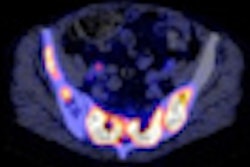Whole-body FDG-PET has high sensitivity for detecting palpable breast cancer, but it is less effective in detecting metastatic disease in axillary lymph nodes, according to researchers from the Kurume University School of Medicine in Fukuoka, Japan.
The researchers presented the results of their study, which evaluated whole-body FDG-PET in 80 women who had palpable breast tumors or positive uptake in whole-body PET scans, at the 2008 American Association for Cancer Research (AACR) meeting in San Diego.
Researchers led by Dr. Mai Mishima noted that FDG-PET has shown high sensitivity but low specificity in detecting breast cancer in previous studies. Mishima and colleagues aimed to evaluate the effectiveness of FDG-PET in detecting primary breast tumors and also metastatic disease in axillary lymph nodes.
In the study, the breast and lymph node lesions scanned by whole-body FDG-PET were evaluated by standard staging studies: CT, MRI, x-ray, or pathology. Of the 80 cases, FDG-PET scans resulted in 76 positive diagnoses -- 66 were true-positive for neoplastic disease and 10 were false-positive for nonneoplastic disease. Of the eight women evaluated at baseline by whole-body PET, four had negative diagnoses, and 100% of these were true-negative for nonneoplastic disease.
The sensitivity, specificity, and accuracy of whole-body FDG-PET for palpable breast masses and metastatic axillary lymph nodes are shown below:
|
The researchers also found that the SUVmax value on FDG-PET was significantly higher in true-positive cases than for false-positive cases. SUVmax was also significantly higher in cases with a histology of solid tubular ductal carcinoma or strong positive expression of HER2 or HER3 proteins, which can denote more aggressive breast cancers.
To further analyze the ability of FDG-PET to detect metastatic disease in axillary lymph nodes, the researchers evaluated the size of the detected metastases. They found that the sensitivity of FDG-PET for detecting larger malignancies (stage T2 or more than 2 cm) was 69%, and for stage T1 metastases (or tumors less than 2 cm), the sensitivity was 33%.
Sensitivity was also greater for cases with a larger number of diseased nodes. For cases involving more than four nodes, the sensitivity was 83%, and for those involving only a single node, it was 14%.
As a result, the researchers concluded that FDG-PET scans can improve the detection of breast cancer, but may be helpful only in evaluating axillary nodal staging.
By Barbara Boughton
AuntMinnie.com contributing writer
May 2, 2008
Related Reading
PEM performs well against breast MRI, whole-body PET, June 6, 2007
NCPIC to provide PET breast scans for uninsured, May 18, 2007
Whole-body FDG-PET of little use in breast cancer staging, November 26, 2006
Preop FDG-PET spots axillary involvement in breast cancer, may obviate biopsy, August 21, 2006
Dual-time-point breast PET increases diagnostic accuracy, December 2, 2005
Copyright © 2008 AuntMinnie.com




















